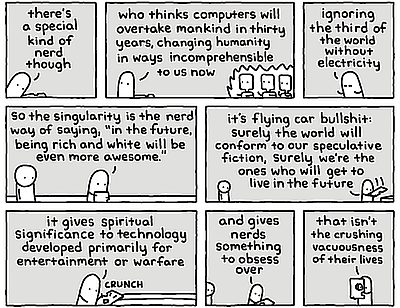Monday, June 30, 2008
Sunday, June 29, 2008
Saturday, June 28, 2008
Friday, June 27, 2008
Thursday, June 26, 2008
Wednesday, June 25, 2008
Monday, June 23, 2008
Saturday, June 21, 2008
Friday, June 20, 2008
Thursday, June 12, 2008
Saturday, June 07, 2008
Tuesday, June 03, 2008
Spectre

The Spectre
At first sight there may seem something strange about the new President’s insistence that the solution to the country’s moral crisis, the goal of his ‘renewal’ process, was ‘to do away with May 68, once and for all’. Most of us were under the impression that it was long gone anyway. What is haunting the regime, under the name of May 68? We can only assume that it is the ‘spectre of communism’, in one of its last real manifestations. He would say (to give a Sarkozian prosopopoeia): ‘We refuse to be haunted by anything at all. It is not enough that empirical communism has disappeared. We want all possible forms of it banished. Even the hypothesis of communism—generic name of our defeat—must become unmentionable.’
What is the communist hypothesis? In its generic sense, given in its canonic Manifesto, ‘communist’ means, first, that the logic of class—the fundamental subordination of labour to a dominant class, the arrangement that has persisted since Antiquity—is not inevitable; it can be overcome. The communist hypothesis is that a different collective organization is practicable, one that will eliminate the inequality of wealth and even the division of labour. The private appropriation of massive fortunes and their transmission by inheritance will disappear. The existence of a coercive state, separate from civil society, will no longer appear a necessity: a long process of reorganization based on a free association of producers will see it withering away.
‘Communism’ as such denotes only this very general set of intellectual representations. It is what Kant called an Idea, with a regulatory function, rather than a programme. It is foolish to call such communist principles utopian; in the sense that I have defined them here they are intellectual patterns, always actualized in a different fashion. As a pure Idea of equality, the communist hypothesis has no doubt existed since the beginnings of the state. As soon as mass action opposes state coercion in the name of egalitarian justice, rudiments or fragments of the hypothesis start to appear. Popular revolts—the slaves led by Spartacus, the peasants led by Müntzer—might be identified as practical examples of this ‘communist invariant’. With the French Revolution, the communist hypothesis then inaugurates the epoch of political modernity.
What remains is to determine the point at which we now find ourselves in the history of the communist hypothesis. A fresco of the modern period would show two great sequences in its development, with a forty-year gap between them. The first is that of the setting in place of the communist hypothesis; the second, of preliminary attempts at its realization. The first sequence runs from the French Revolution to the Paris Commune; let us say, 1792 to 1871. It links the popular mass movement to the seizure of power, through the insurrectional overthrow of the existing order; this revolution will abolish the old forms of society and install ‘the community of equals’. In the course of the century, the formless popular movement made up of townsfolk, artisans and students came increasingly under the leadership of the working class. The sequence culminated in the striking novelty—and radical defeat—of the Paris Commune. For the Commune demonstrated both the extraordinary energy of this combination of popular movement, working-class leadership and armed insurrection, and its limits: the communards could neither establish the revolution on a national footing nor defend it against the foreign-backed forces of the counter-revolution.
The second sequence of the communist hypothesis runs from 1917 to 1976: from the Bolshevik Revolution to the end of the Cultural Revolution and the militant upsurge throughout the world during the years 1966–75. It was dominated by the question: how to win? How to hold out—unlike the Paris Commune—against the armed reaction of the possessing classes; how to organize the new power so as to protect it against the onslaught of its enemies? It was no longer a question of formulating and testing the communist hypothesis, but of realizing it: what the 19th century had dreamt, the 20th would accomplish. The obsession with victory, centred around questions of organization, found its principal expression in the ‘iron discipline’ of the communist party—the characteristic construction of the second sequence of the hypothesis. The party effectively solved the question inherited from the first sequence: the revolution prevailed, either through insurrection or prolonged popular war, in Russia, China, Czechoslovakia, Korea, Vietnam, Cuba, and succeeded in establishing a new order.
But the second sequence in turn created a further problem, which it could not solve using the methods it had developed in response to the problems of the first. The party had been an appropriate tool for the overthrow of weakened reactionary regimes, but it proved ill-adapted for the construction of the ‘dictatorship of the proletariat’ in the sense that Marx had intended—that is, a temporary state, organizing the transition to the non-state: its dialectical ‘withering away’. Instead, the party-state developed into a new form of authoritarianism. Some of these regimes made real strides in education, public health, the valorization of labour, and so on; and they provided an international constraint on the arrogance of the imperialist powers. However, the statist principle in itself proved corrupt and, in the long run, ineffective. Police coercion could not save the ‘socialist’ state from internal bureaucratic inertia; and within fifty years it was clear that it would never prevail in the ferocious competition imposed by its capitalist adversaries. The last great convulsions of the second sequence—the Cultural Revolution and May 68, in its broadest sense—can be understood as attempts to deal with the inadequacy of the party.
-Alain Badiou
Subscribe to:
Posts (Atom)
